Elevator pitch
Norway has a high labor force participation rate and a very low unemployment rate. Part of the reason for this fortunate situation is so-called “tripartism”: a broad agreement among unions, employers, and government to maintain a high level of coordination in wage bargaining. This has led to downward real wage flexibility, which has lessened the effects of negative shocks to the economy. Reduced net immigration, especially from neighboring countries, has also mitigated the negative effects of the recent drop in oil prices. A potential drawback of this tripartism is, however, the difficulty of reducing employee absences and disability.
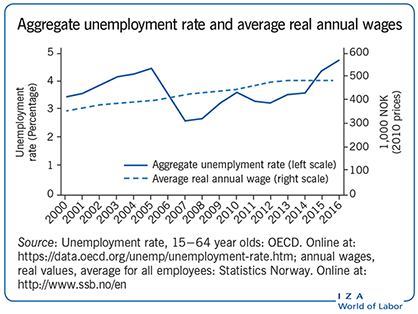
Key findings
Pros
Both men and women enjoy high employment rates.
Real wage flexibility has helped combat unemployment, especially after the drop in oil prices in 2014.
Unemployment is quite low, including among young individuals.
There is a downward-sloping trend of part-time work among women.
Wages are compressed, and wage inequality is rather small and relatively stable.
Cons
Worker absences due to sickness as well as disability rates are high, putting pressure on the welfare state.
The overall employment rate is trending downwards possibly related to an aging population.
The labor market is highly gender-segregated with respect to sector and occupation.
The school drop-out rate has started to increase among young men.
Author's main message
Overall, the Norwegian labor market is performing very well. The severe drop in oil prices in 2014 led to fewer jobs in the oil sector. However, the downward flexibility of real wages and increased demand in other export-oriented industries dampened any potential negative employment effects. The employment rate among women is very high, but there are challenges due to a gender-segregated job market and a persistent raw gender wage gap of 15%. Norway’s substantial welfare system helps parents remain in the labor market, but an aging workforce and high worker absenteeism due to illness and disability are concerning.
Motivation
One important factor behind the well-functioning Norwegian labor market, with low unemployment and high employment rates for both men and women, is so-called “tripartism.” This involves cooperation amongst unions, employers, and government to generate competitiveness through modest wage increases, thereby ensuring high employment. However, this tripartism might come at a cost of high worker absence and high disability rates, which are not directly related to health conditions. This raises concerns about the sustainability of the welfare state.
Discussion of pros and cons
Employment and unemployment
By international comparison, the employment rate is very high in Norway, both for men and women (Figure 1). The overall employment rate of 74% is at the high end among the OECD countries. Moreover, women now account for 47% of the workforce, which is very high internationally. Employment rates of both men and women have decreased only marginally since 2000; in 2016, they were 75% for men and 73% for women.
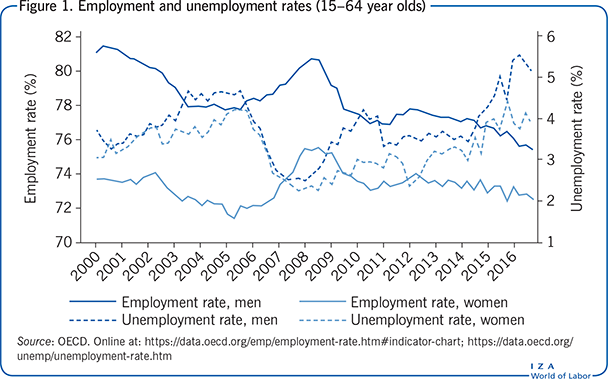
The high employment rates are mirrored by low unemployment rates, which were 5% for men and 4% for women in 2016. The youth unemployment rate (among the 15–24 year olds) is also low compared to the OECD average (9.1% and 12.2% for men and women respectively in Norway at the end of 2016, versus 12.1% and 13.2% in the OECD as a whole), though it is higher than comparable numbers for Germany. The fluctuations in unemployment have been larger for men than for women. This is related to a highly gender-segregated labor market, where men dominate those sectors that face stronger international competition, such as the petroleum industry and manufacturing. Sectors where women typically work are education, health, and public services. These latter sectors usually show less fluctuation. The slump in oil prices in 2014, followed by a drop in investment in the petroleum industry, has thus led to a slight increase in the unemployment rate during the last several years, especially among men.
One potential way to combat increasing unemployment is to create more jobs in the public sector. When looking at the share of public sector employment relative to the total number of employed, this ratio has grown somewhat since 2000 (Figure 2). However, there does not seem to have been any particular activity in recent years in response to the oil price drop. This can be seen as an example of the Baumol effect, where increasing employment in the service sector and declining employment levels in the manufacturing sector are observed. Using 2013 as a benchmark, as the drop in oil prices took place in 2014, the absolute increase in public employment between 2013 and 2016 was 30,000, while the decrease in private employment was 56,000. Nevertheless, the increase in public-sector employment seems to follow a long-term trend and is relatively unaffected by business-cycle fluctuations. Private-sector employment, on the other hand, has been more volatile, following business cycle fluctuations.
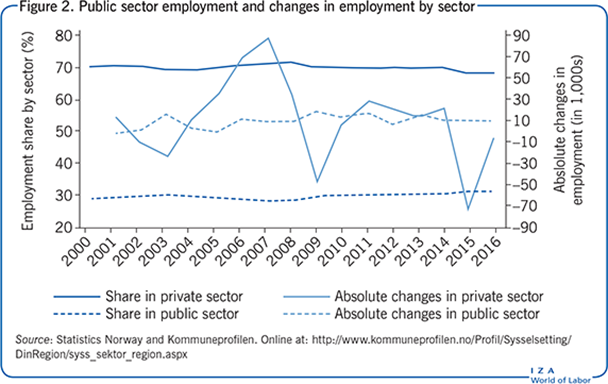
Another factor behind the rather modest effect of the drop in oil prices is reduced net migration from nearby countries (Figure 3), especially Sweden and Poland, which served to dampen the pressure in the Norwegian labor market. This is partly driven by the depreciation of the Norwegian krone and the improved labor market in Sweden.
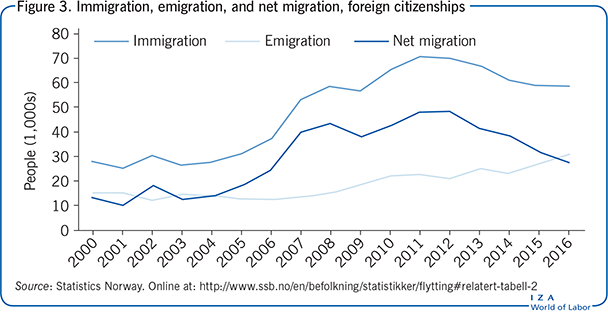
Hours worked
Normal full-time work in Norway is 37.5 hours per week. When examining registered hours worked, it becomes apparent that men are working full weekly hours, while women on average are working 31 hours per week (Figure 4). Approximately 10% of men work part-time, in contrast to between 25% and 30% of women. This is related to child rearing, as women still take the main responsibility for childcare. The share of women working part-time in Norway is significantly higher than the EU average, though it has been decreasing since the turn of the century. In 2016, the average number of hours worked per year by women was 1,430 in Norway, below the average in the OECD and far below the US average of approximately 1,750 hours annually.
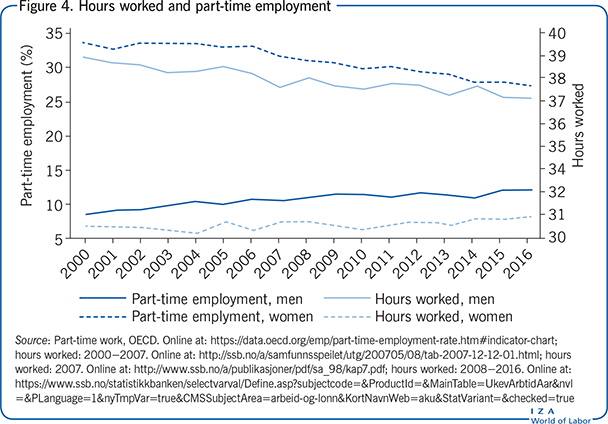
Absence due to disability and sickness
As seen in Figure 1, unemployment rates are relatively low in Norway. However, it has been suggested that the high proportion of the working-age population receiving disability benefits in Norway represents disguised unemployment [1]. It has been found that approximately 28% of all new disability recipient cases are related to restructuring and job destruction. Thus, a large percentage of disability insurance claims can be directly attributed to job displacement and other adverse shocks to employment opportunities. Due to the fact that disability in Norway is treated as an absorbing state, in that benefits are essentially permanent until the official retirement age of 67, this represents a serious concern in the labor market. Additionally, researchers have found a significant positive intergenerational correlation in the receipt of disability pensions, such that offspring of disability recipients have a higher probability of ending up as disability recipients compared to otherwise identical individuals (see, for instance, [2]). This implies that another concern is potential spillover effects to future generations in the workforce.
Figure 5 (left axis) shows disability recipiency rates for both men and women from 2000 to 2016. As seen in the figure, a fairly constant 11% to 12% of the female population aged 18–67 has received disability benefits during this period. For men, the corresponding numbers are between 8% and 9%. Among 60–64 year olds, one-third of women and nearly one-quarter of men are on disability benefits. This offers a clear indication that disability benefits are an important route to early retirement. OECD numbers show that the disability benefit recipient rate in Norway, together with the other Scandinavian countries, is considerably higher than the average across all OECD countries. Even though eligibility for disability benefits is primarily based on an individual’s health status, other factors are also taken into consideration, such as age, education, labor market prospects, and ability. The large number of disability benefit recipients reduces the potential workforce and threatens the sustainability of the welfare state.
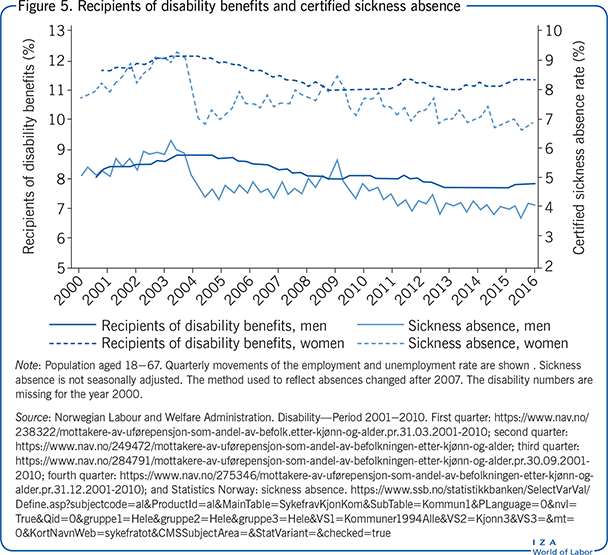
Not only is the number of recipients of disability benefits alarmingly high, but the proportion of employee absences due to sickness is also very high in Norway, and much higher for women than for men. The generosity of the welfare state is likely to be part of the explanation for the high incidence of sickness absence as well as the disability numbers. The average replacement rate when someone is on disability benefits is 50–60% before taxes. Due to the progressive income tax and allowances, the replacement rate after tax is actually considerably higher. The replacement rate for sickness absence is 100% from the first day of sickness, and eligibility for sickness absence benefits lasts for up to 12 months. Beyond 12 months, workers are eligible for rehabilitation or disability benefits if their work capacity is reduced by at least 50%.
Wages and earnings
Figure 6 shows annual gross earnings separately for men and women. As seen, the raw gender wage gap has been quite stable over the sample period, with women earning on average 15–16% less than men. Norway’s failure to close this gap contrasts with the EU27 average, where the unadjusted gender pay gap decreased by 1.5 percentage points over the same period.
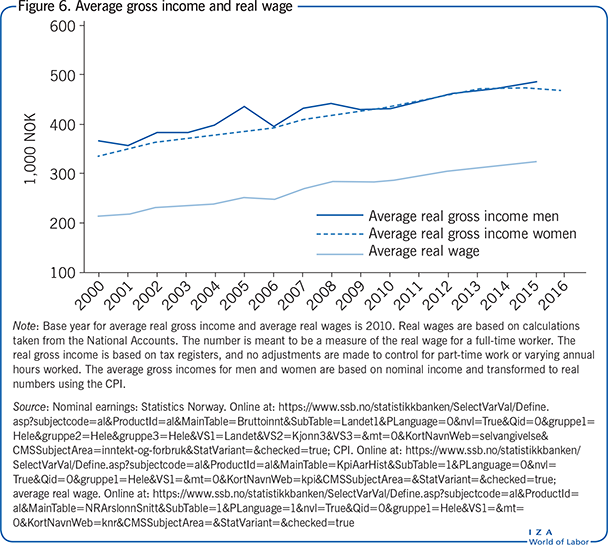
While there has not been significant progress with respect to the gender wage gap in Norway, wages have played an important role in the country’s overall economic success. Tripartism and its resulting real wage flexibility is an important factor in explaining the relatively high employment rate and low unemployment rate over the previous decades, and particularly so after the oil price drop in 2014. The real wage increase was very modest in 2015, and even negative in 2016. The tripartite system is aided by the high degree of unionization (approximately 55%) in Norway, and even higher union coverage—the share of workers covered by collective agreements—(almost 80%). The role of the government in this collaboration is to support coordination through institutional arrangements, but also to give signals about related issues, such as pension reforms, labor market regulations, efforts in battling unemployment, absenteeism, undeclared work, and poor working conditions. The collective agreements have also resulted in high wage compression.
Wage compression in Norway is more significant in the public than in the private sector (Figure 7), which is to be expected. It is also evident that wage compression has been rather stable over time, especially in the public sector. Turning to the private sector, the 90/10 ratio increased from 2.4 in 2000 to 3.1 in 2016, showing that inequality between high and low wages has grown over time. This suggests that the traditional solidarity in the labor market is under pressure. A closer look suggests that the rise in inequality was particularly noticeable during the three most recent years. Globalization and skill-biased technological change are often used as explanations for growing inequality in developed countries [3]. Nevertheless, across OECD countries, Norway ranks low in terms of income inequality as measured by the 90/10 ratio. Only the Czech Republic and Denmark have lower ratios.
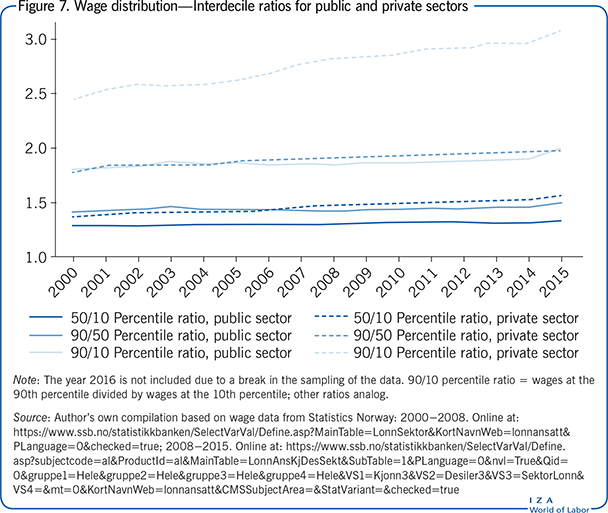
Gender balance
The employment rate for women has been high by international comparison for several decades. One important factor behind the general trend is increasing entry by women into higher education. In 2000, women overtook men in the proportion with higher education (more than 13 years), and since then men have fallen further behind (Figure 8).
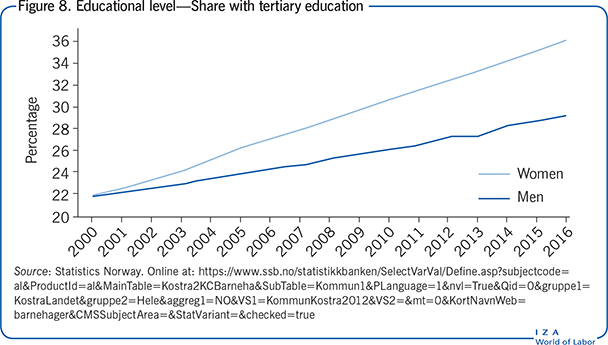
Another potential explanation for the high female employment rate is the availability of subsidized childcare. As shown in Figure 9, for older pre-school children (3–5 years old), childcare coverage is above 95% (all children in Norway start elementary school in the calendar year they turn six). Among the youngest children, aged 1–2 years, the coverage rate is 80%. These rates are high from an international perspective.
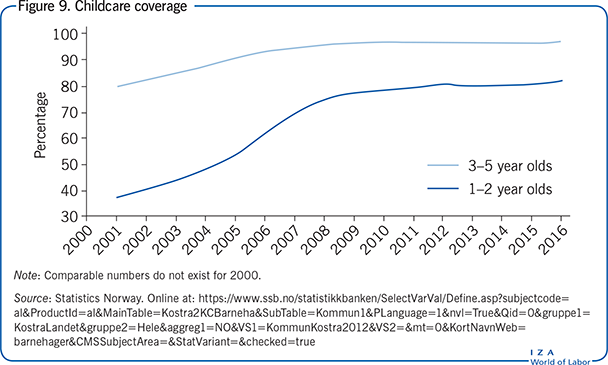
The other pillar of Norwegian family policy is paid maternity leave, including job-protected leave, to facilitate the balancing of family and work. Since 1993, parents have been entitled to at least 42 weeks of parental leave, including four weeks of paternity leave. The number of compensated weeks has been steadily increasing over time, and since 2014 parents have received a total of 49 weeks (split between both parents). In 2014, the paternity quota was 14 out of 49 weeks, which the family lost if the father did not take the paid leave. The father’s quota was reduced in 2015 and is now ten weeks. There is an ongoing debate about whether the gender wage gap is partly explained by the length of maternity leave, and that the father’s leave quota should be increased again as a result. This could have an effect on female/male differences in the labor market, since almost all eligible fathers do take the minimum paternity leave allowed, and very few take more.
Employment rates and education levels are high for Norwegian women compared to other countries, but women still enter very different occupations and industries than men, which creates a gender-segregated labor market. Most women in Norway work in the public sector (approximately two-thirds)—for example, education, care, and health. The majority of men work in the private sector (approximately two-thirds), with many working in manufacturing and construction. Typically, male-dominated occupations are vocational training occupations, such as engineering, transport, and agriculture. By contrast, female-dominated occupations often include kindergarten and primary school teaching, nursing, and eldercare.
A final reason for labor market differences between men and women stems from the transition from school to work. The school drop-out rate for young men is higher than for young women. The completion rates of upper secondary education—the proportion of students entering an upper secondary education program who graduate within two years after the theoretical duration of the program—were 78% for girls and 70% for boys in 2015, which is very similar to the OECD average (see [4]—Figure A9.1). The gender gap in completion rates is mirrored in Figure 8, showing educational attainment. With fewer low-skilled jobs available in Norway in recent years, men in particular are having a hard time getting established in the labor market. It is thus unsurprising that the increase in disability benefits among young adults is concentrated among men.
Limitations and gaps
There is currently a discussion ongoing in Norway about unemployment rates and the extent to which individuals on temporary training and rehabilitation programs should be counted in official unemployment statistics. The same is true with respect to individuals not eligible for unemployment benefits, typically students with no recent work experience. Some argue that the true Norwegian unemployment rate is higher than that which the current official numbers indicate. One alternative would be to have measures of unemployment or underutilization, similar to those published by the US Bureau of Labor Statistics.
The generosity of the welfare state has contributed to the high participation rate of women and made it possible to combine family and work. However, it is still an open question whether this generosity comes with a cost. Research has pointed out that mothers are less likely to be promoted than women without children, and that they tend to enter at lower-level jobs [5]. Despite this finding, a large part of the family gap (the differences between mothers and non-mothers) remains unexplained.
Summary and policy advice
The Norwegian economy has responded quite well to the drop in oil prices and associated slump in oil-related investments. Part of this is due to downward real wage flexibility and increased demand for labor in other industries. This latter increase has been stimulated by a depreciation of the Norwegian kroner. Moreover, politicians have ignored the temptation to increase public-sector employment. This is a reasonable position given the need for structural changes in the Norwegian labor market—moving away from the petroleum industry and toward a greater focus on other industries.
A significant concern looking ahead though is related to the size of the workforce. Despite high fertility and immigration rates, an aging population coupled with high absenteeism and disability rates have reduced the workforce and increased pressure on public budgets. This threatens the sustainability of the welfare state. However, none of the political parties are willing to cut benefits in response to this situation, and even if they were, such cuts might put the beneficial tripartite system under pressure.
Acknowledgments
The author thanks an anonymous referee and the IZA World of Labor editors for many helpful suggestions on earlier drafts. The author also thanks Felix Kapfhammer for excellent research assistance and Astrid Kunze for valuable comments and suggestions.
Competing interests
The IZA World of Labor project is committed to the IZA Guiding Principles of Research Integrity. The author declares to have observed these principles.
© Øivind A. Nilsen